Kiwifruit is produced by a large, deciduous vine known botanically as Actinidia deliciosa. Kiwi has high nutrient demands, especially for nitrogen and potassium.
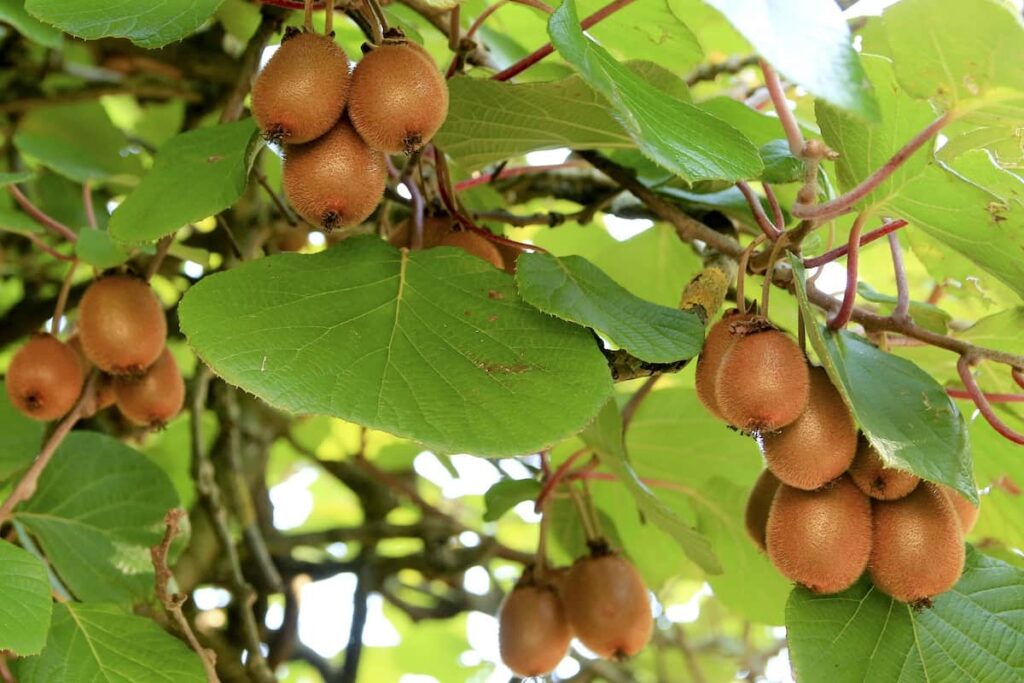
How to grow Kiwi in USA
Soil and land preparation for Kiwi framing in the USA
The optimum soil pH for Kiwi fruit is 5.6 and 6.0. Kiwi vines show poor growth at pH values outside this range. Kiwi vines do best in deep, well-drained soil. They are sensitive to standing water, mainly after a bud break in the spring. Kiwifruit needs a location in full sun and should be protected from the wind. Frost-prone areas should be avoided. To prevent spring frost injury and to protect plants from southwest winds in summer, a site with a gentle north-facing slope is preferred.
A deep, well-drained sandy loam soil with added organic matter is ideal. The soil should be deeply tilled a year before planting, which will greatly aid weed control. In California, Kiwifruit is planted in 3 feet of well-drained soil. However, ‘Hayward’ vines grow well on soil with an effective rooting depth of 2 feet, provided the water table is less than 2 feet. Kiwiberry vines in Oregon have done well when planted on typical valley floor soils but still benefit from planting in raised beds at least 1 foot high.
If needed, improve drainage before planting by installing well-designed drain tiles. Ripping up the soil under the row before planting can also benefit growth. Prepare the land by tilling for weed-free planting. Mix in the recommended fertilizer and lime two to three weeks before planting. Add organic matter like peat moss or composted cow manure to the top 3 to 6 inches of soil. Allow rain to settle the beds, or use a sprinkler.
Different Kiwi varieties available in the USA
- There are, in fact, different varieties of Kiwi fruit. Kiwis with fuzzy exteriors that we are used to in grocery stores are mostly tropical/subtropical fruits. However, hardy Kiwi is better suited to temperate climates, ranging from cold USDA zone 5 (Wisconsin) to very warm zone 9 (Louisiana). Some Russian cultivars can also tolerate colder areas.
- Hardy Kiwis are also slightly smaller, about the size of gooseberry or large grape, and have pink skin. Today, the most common variety is Hayward, grown almost exclusively in California.
- arguta, known as hardy Kiwi or arguta (sold as baby Kiwi in Oregon and grape Kiwi in British Columbia). This species shows promise for commercial production in the United States.
- Actinidia chinensis is related to A. deliciosa. Selections are made for hairlessness, aroma, flavor, and red or yellow flesh. It is a small fruit well suited to southern Oklahoma (USDA Hardiness Zone 7).
- Actinidia arguta is a hardy Kiwi. Small fruit with smooth skin. Keeps 2 to 3 months in storage. Bear in 3 to 4 years. Plant 6 to 8 females per male plant. It ripens in late summer.
In case you missed it: Kiwi Farming, Kiwi Planting, Kiwi Fruit Cultivation Practices
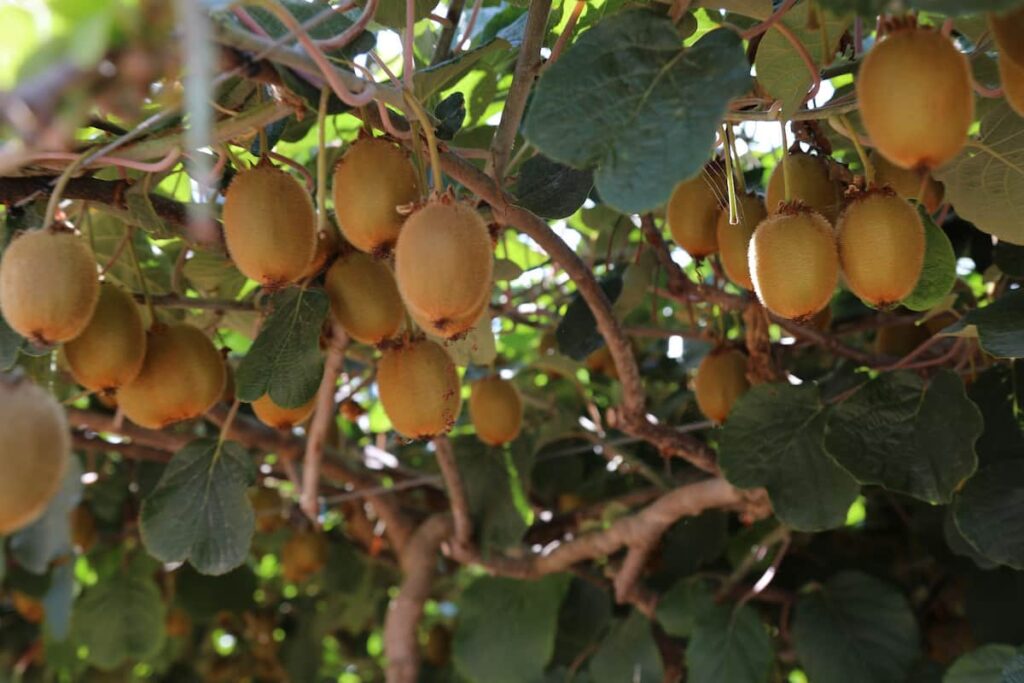
Where is the most Kiwi grown in the US?
In the US, Kiwis are grown commercially in California, with some hardy varieties in the Pacific Northwest. Oregon is a leading producer of Kiwi berries in the United States, but they are also grown in many other regions of the United States and other countries. The commercial area has been limited primarily by marketing factors, such as the development of fresh markets for this relatively uncommon fruit, limited fruit size, the limited ripening period for available cultivars, and the relatively short storage and shelf life compared to fuzzy Kiwifruit.
In California, Kiwi can be grown in most regions of the Sacramento and San Joaquin Valleys, where fruits are grown. However, they cannot tolerate strong winds, poor drainage, or alkaline soil. The major Kiwifruit trade districts in the Central Valley are Chico, Gridley, Yuba City-Marysville, Modesto-Livingston, Madera, Fresno, Reedley-Dinuba, Visalia-Exeter, Porterville, and Delano-McFarland. In Southern California, the lack of warm days or the winter cold in December and January reduces yield for many years.
In the foothills and northern coastal regions, frost limits production. In many areas, wind stains the fruit and breaks the growing and fruiting canes, thereby delaying plant growth and reducing yields. Casurina windbreaks can reduce wind problems. In the Sacramento Valley, heavy spring rains have killed Kiwifruit vineyards on poorly drained land. Nematodes and water problems limit plant growth in sandy soils in the San Joaquin Valley.
Irrigation management for Kiwi farming in the USA
Kiwifruit production requires an abundant supply of good-quality water. Water should be available during the planting season through rainfall or irrigation. Irrigation is necessary to keep the vines growing and productive and to maximize fruit size. Almost all the water taken up by the Kiwi fruit vine is lost through transpiration, a process in which water vapor in the plant is transferred to the atmosphere; the plant uses only a small part.
Irrigation is very important for optimal plant growth and good yield. Three different irrigation methods are used for Kiwifruit vineyards. Drip irrigation saves water and is usually used on mostly young plants. An emitter is placed near each plant at planting time and for the first year. In the second year, an emitter is placed about 12-18 inches from the plant on each side of the plant. When the plant is approximately about 4 years old, two more emitters are added 3 feet apart from the first emitters.
A drip system can water the vines every 2 days, which usually results in faster growth. However, when plants reach full effect, it isn’t easy to wet enough soil with 4 amperes per vine for maximum yield and plant growth. At this point, many growers shift to mini sprinklers for irrigation or add more emitters per vine.
In case you missed it: Top 15 Steps to Boost Kiwi Yield: How to Increase Production, Fruit Size, and Quality
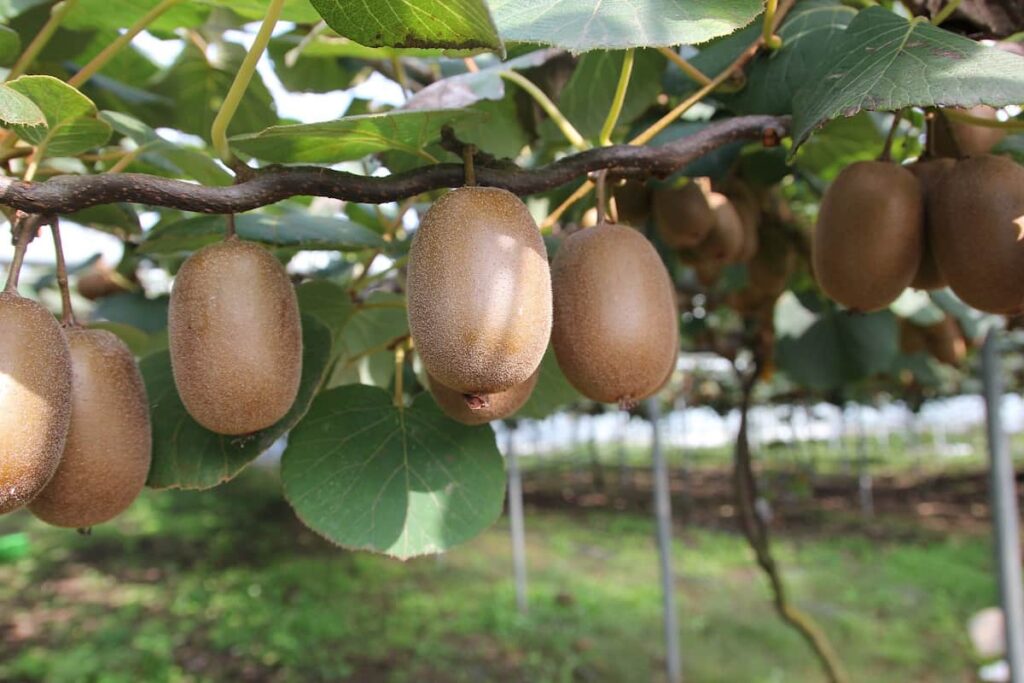
Training young Kiwi plants
Train single shoots up to the top center wire of the trellis by removing any background growth. Tie the shoots, which will form the stem, loosely to a stake or bamboo pole. Keep the stem straight and prevent it from twisting around the stake or bamboo pole. It is important to keep the new shoot as straight as possible as this shoot will form the future stem and will contribute some weight to the plant in years to come.
Train the shoot along the center wire in one direction. The following year, a shoot will be trained in the opposite direction along the center wire. These two shoots will form a permanent guide on the vine. Avoid twisting these leaders around the center wire, as this can weaken the vine in future years. The background rods produced from these leaders are perpendicular to the leaders by outer wires. These canes will be the fruiting canes next year.
Winter protection care for Kiwi farming
Choose plant species that are winter hardy in your area. Kiwifruit blooms about 60 days after the plant buds open, so the flowers won’t have to deal with freezing temperatures. Some frost protection may be necessary if spring frosts threaten leaf bud swelling. Due to the large size of the plants, covering them is often impractical. However, if they are continuously sprayed with water during the entire time the temperature is below freezing, it can provide some protection from frost. Ice accumulation may cause some breakage of vines.
Temperature and humidity requirement for Kiwi farming in the USA
Kiwis prefer moderate temperatures, although they require a cool period to set fruit. Additionally, grapes can tolerate hot summer temperatures of up to 45°C, although they will need extra water to compensate. Kiwifruit is not particularly picky regarding moisture requirements and will do just fine in the moisture levels of its USDA hardiness zones.
Kiwi plant care
Growing Kiwi can be a bit involved, but the payoff — tons of delicious, sweet fruit — is well worth it. Although the fruit is classified as a berry, each Kiwi is about 3 inches long and egg-shaped, with a brown exterior. Therefore, Kiwi fruit vines are ideal for growing on wooden structures such as gazebos, trellises, pergolas, arbors, or fences.
When planning where to plant a Kiwifruit vine, ensure you have enough space and support for at least two vines, as you need both a male and a female for the successful pollination of this heterozygous species. Plants will be needed. The flowers may be cream or yellow and have a mild fragrance. Proper watering and pruning methods are especially important for Kiwifruit vines because the fruit is formed on perennial wood.
In case you missed it: Kiwifruit Gardening For Beginners – How to Start
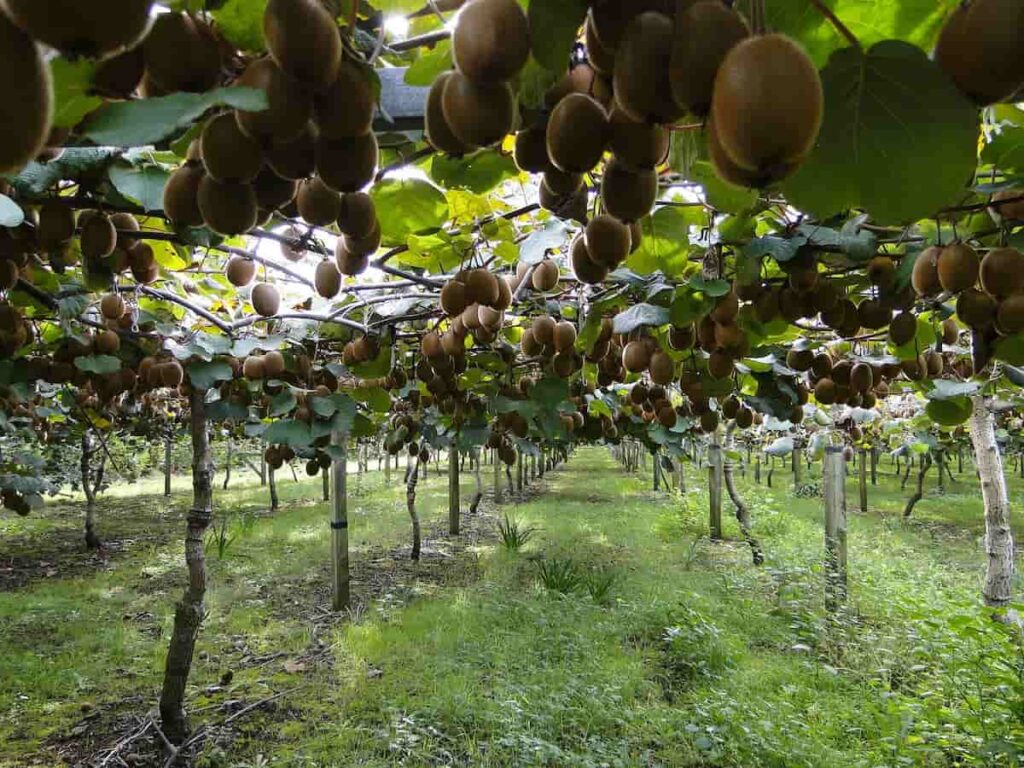
Fertilization and pruning importance in Kiwi farming
Urea or organic fertilizer products work to provide nutrients to Kiwifruit vines as long as the soil pH is within an acceptable range. In young vines, apply any essential nutrients other than nitrogen (N) before planting based on a soil analysis. In mature plantings, soil analysis in the fall can be used to decide if nutrients other than N are needed. Also, tissue analysis on mature vines is an important tool for modifying fertilization programs for all nutrients.
The roots of Kiwifruit plants are very sensitive to fertilizer burn or high salinity, especially near the stem. Symptoms of fertilizer burn include leaf necrosis or darkening of leaf edges and stunted growth. However, proper training during the establishment years is necessary to develop the framework (permanent structure) of the vine so that it can be harvested properly and most efficiently each year when the vines mature. Proper pruning and training are important for several reasons:
- Establishing and maintaining a well-formed permanent framework for the bull during the establishment years.
- Achieving a balance between plant growth and fruit production when the vines are mature.
- To maintain consistent yield and fruit size year after year.
- To develop a canopy that uses available light efficiently (for photosynthesis) but is open enough to achieve optimum fruit quality and flower bud formation for next year’s crop.
Pests and diseases management for Kiwi framing in the USA
- Root-knot nematodes are parasitic worms that attack plant roots, causing “knots” to form. The leafroller caterpillar is the most common and damaging insect and eats holes in the fruit, causing scarring, especially where two or three fruits are touching.
- In late summer or early fall, thrips can cause the browning of leaves. Greedy-scale insects attack leaves, bark, and fruit, killing growth tips. The boxelder bug feeds on buds and fruit, causing deformation and drop.
- Crown gall affects Kiwi vines and can be avoided by exposing the upper roots. Unfortunately, roots can also be attacked by Phytophthora cactorum, and P. cinnamomi can also attack the roots, causing root rot and killing the entire plant.
- Botrytis cinerea affects flowers and fruits and is found in most growing areas. However, the biggest threat to Kiwifruit is postharvest gray mold, which enters the skin through small cracks when stored at high humidity.
- Kiwifruit vine disease is a bacterial canker that causes halo-like spots on the leaves, browning of the buds, and red gum growth on the plant. The disease is spread by windborne pollen, heavy rains, humans, and animals and is most pronounced during cool temperatures and high humidity.
- Phytophthora crown and root rot – Soggy and poorly drained soils and high humidity are responsible for Phytophthora crown and root rot, a disease easily seen by reddish-brown roots and crowns. The disease can be prevented by proper moisture management. Insecticides are sometimes effective.
- Botrytis Fruit Rot – Also known as gray mold, Botrytis fruit rot causes mature Kiwifruit to soften and shrivel with a gray growth that appears mostly on the stem. It is more common during the rainy season or periods of high humidity. Fungicides can be effective when applied during the pre-harvest period.
- Crown gall – This bacterial disease enters the plant through wounded areas. Crown gall is best prevented by avoiding injury to the vines. Unfortunately, there is no chemical control for crown gall, which results in weak plants, smaller leaves, and reduced yield.
In case you missed it: Vegetable Plant Spacing Chart in India: Seed Spacing, Plant to Plant Distance, and Row to Row Distance
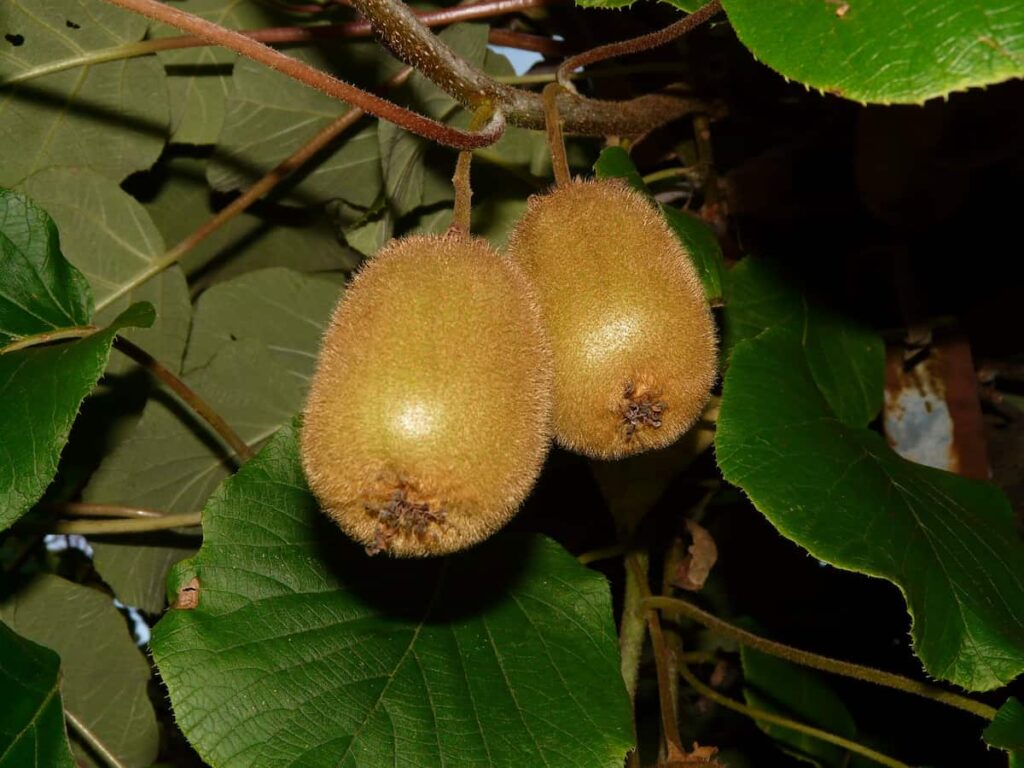
When and how to harvest Kiwi fruits?
Kiwifruit should be picked before the first frost. Ripe green fruit will store longer than soft, ripe fruit. However, if the fruits are picked too early, they will not ripen properly, and their quality will be poor. To pick Kiwifruit, remove them from the plant, leaving the fruit stalks on the vine. Handle the fruit gently and wear gloves to prevent damage to their skin. Ripe green Kiwifruit is firm and sharp, with a nice green color inside.
Fruit that ripens on the vine is good to eat but will not store unless the fruit is first picked. Be careful when harvesting Kiwifruit handles, as they bruise easily, and damaged fruit has a limited storage life. To harvest a Kiwi, pull the stem at the base of the fruit. Again, softness is not a great determinant for preparation. Size, date, and when in doubt, open the fruit to access the seeds—when the seeds turn black, it’s time to harvest the Kiwi fruit.
When harvesting a Kiwi, remove the larger fruit and leave the smaller ones on the vine to gain some size. Kiwi will continue to ripen once picked, so pick a few full-sized fruits and let them sit on the counter for a few days. The crop is ready for harvesting, like grapes, if they become soft and sweet. However, if the Kiwi fruit is hard, wait a little longer to harvest.
Frequently asked questions about Kiwi fruit farming in the USA
Can Kiwis be grown in the US?
Kiwifruit production in the USA is mostly concentrated in California because Kiwifruit is not cold hardy. Hardy Kiwi is also known as Kiwi berry.
In which states can you grow Kiwi?
Meander, Saanichton 12, and Blake are excellent Kiwi plants for warmer regions like California. However, colder zones like Vermont or Maine are not spared. Arctic Kiwi is a plant that can grow in extremely cold conditions.
Is Kiwi easy to grow?
Kiwi fruit vines are strong, sturdy, and easy to grow. However, they need a lot of space on a strong support structure and will take three to five years to bear fruit.
Do Kiwi plants require a lot of water?
Kiwi plants require copious amounts of water throughout the growing season but should also be in well-drained soil. Regular watering is essential in the heat of summer. Never allow the plant to go through drought stress.
In case you missed it: Low-Maintenance Indoor Vertical Garden Ideas, Tips, Techniques, and Secrets
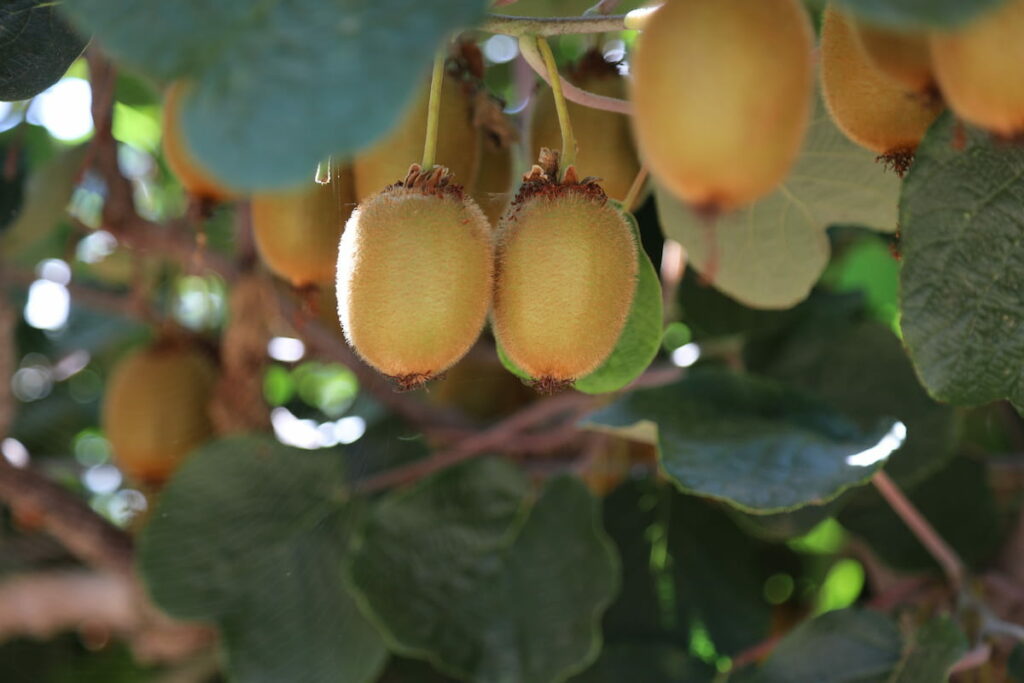
How do you increase the size of Kiwi fruit?
Nitrogen is an essential factor for better and larger production of Kiwifruit. In the first half of plant growth, nitrogen feeders need multiple applications. Nitrogen application will improve fruit size, but caution is still advised as the fruit may be stored poorly later.
Conclusion
Kiwifruit farming is a more profitable business. Kiwi fruit is distinct from other commercial perennial fruit and nut crops commonly grown in California. As a result of this distinct growth, the establishment and management of Kiwifruit orchards differ from the normal training and harvesting practices used in other fruit and nut crops.
- Economical Aquaculture: A Guide to Low-Budget Fish Farming
- 15 Common Planting Errors That Can Doom Your Fruit Trees
- How to Make Houseplants Bushy: Effective Tips and Ideas
- Innovative Strategies for Boosting Coconut Pollination and Yield
- Pollination Strategies for Maximum Pumpkin Yield
- The Complete Guide to Chicken Fattening: Strategies for Maximum Growth
- Natural Solutions for Tulip Problems: 100% Effective Remedies for Leaf and Bulb-Related Issues
- Revolutionizing Citrus Preservation: Towards a Healthier, Greener Future
- Natural Solutions for Peony Leaf and Flower Problems: 100% Effective Remedies
- Maximizing Profits with Avocado Contract Farming in India: A Comprehensive Guide
- Natural Solutions for Hydrangea Problems: 100% Effective Remedies for Leaf and Flowers
- The Ultimate Guide to Choosing the Perfect Foliage Friend: Bringing Life Indoors
- From Sunlight to Sustainability: 15 Ways to Use Solar Technology in Agriculture
- The Ultimate Guide to Dong Tao Chicken: Exploring from History to Raising
- The Eco-Friendly Makeover: How to Convert Your Unused Swimming Pool into a Fish Pond
- Mastering the Art of Delaware Chicken Farming: Essentials for Healthy Backyard Flocks
- 20 Best Homemade Fertilizers for Money Plant: DIY Recipes and Application Methods
- How to Craft a Comprehensive Free-Range Chicken Farming Business Plan
- Brighten Your Flock: Raising Easter Egger Chickens for Beauty and Bounty
- How to Optimize Your Poultry Egg Farm Business Plan with These Strategies
- Subsidy for Spirulina Cultivation: How Indian Government Schemes Encouraging Spirulina Farmers
- Ultimate Guide to Raising Dominique Chickens: Breeding, Feeding, Egg-Production, and Care
- Mastering the Art of Raising Jersey Giant Chickens: Care, Feeding, and More
- Ultimate Guide to Raising Legbar Chickens: Breeding, Farming Practices, Diet, Egg-Production
- How to Raise Welsummer Chickens: A Comprehensive Guide for Beginners
- How to Protect Indoor Plants in Winter: A Comprehensive Guide
- Ultimate Guide to Grow Bag Gardening: Tips, Tricks, and Planting Ideas for Urban Gardeners
- Guide to Lotus Cultivation: How to Propagate, Plant, Grow, Care, Cost, and Profit
- Agriculture Drone Subsidy Scheme: Government Kisan Subsidy, License, and How to Apply Online
- Ultimate Guide to Raising Araucana Chickens: Breed Profile, Farming Economics, Diet, and Care
- Bringing Hydroponics to Classroom: Importance, Benefits of Learning for School Students
- Ultimate Guide to Raising Polish Chickens: Breed Profile, Farming Economics, Diet, and Care
- Ultimate Guide to Raising Australorp Chickens: Profile, Farming Economics, Egg Production, Diet, and Care
- Silkie Chicken Farming: Raising Practices, Varieties, Egg Production, Diet, and Care
- Sussex Chicken Farming: Raising Practices, Varieties, Egg Production, Diet and Care
- Homemade Feed Formulations for Livestock: Discover Cost-effective Starter to Finisher Feed Recipes